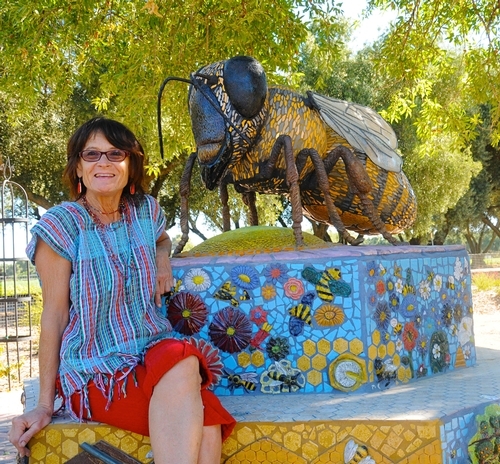
It was the fall of 2009 when a half-acre bee garden on Bee Biology Road, UC Davis campus, sprang to life.
Headlines on colony collapse disorder dominated the news media, as scientists declared "honey bees are in trouble."
Under the direction of interim department chair Lynn Kimsey, UC Davis Department of Entomology and Nematology, a crew installed the Häagen-Dazs Honey Bee Haven (named for it major donor) on Bee Biology Road, next to the Harry H. Laidlaw Jr. Honey Bee Research Facility.
Fast forward to the fall of 2019.
A 10th anniversary celebration will take place from 10 a.m. to 2 p.m., Saturday, Sept. 28. It will include sales of plants and native bee condos, honey tasting (honey from Sola Bee Honey, Woodland), catch-and-release bee observation and identification, and beekeeping and research displays. Several mini lectures are planned.
Visitors will see analemmatic sundial--the only one of its kind in the Sacramento area--and they can discuss the sundial with dial master and beekeeper Rick Williams, M.D. to learn how the dial was created and the links between human and bee perception of the sun. Visitors also will learn about "our research on bee use of ornamental landscape plants," said manager Chris Casey. In addition, visitors can "donate a book on insects, gardening, or nature for our Little Free Library," she announced.
The schedule:
- 10:30 a.m.: Donor and volunteer recognition
- 11 a.m.: Hive opening by beekeeper from the California Master Beekeepers' Association
- 11:30: Mini lecture, "Getting Started with Beekeeping"
- 12: Mini lecture, "Plants for Bees"
- 12:30: Mini lecture, "Using Solitary Bee Houses
- 1 p.m.: Hive opening by beekeeper from the California Master Beekeepers' Association
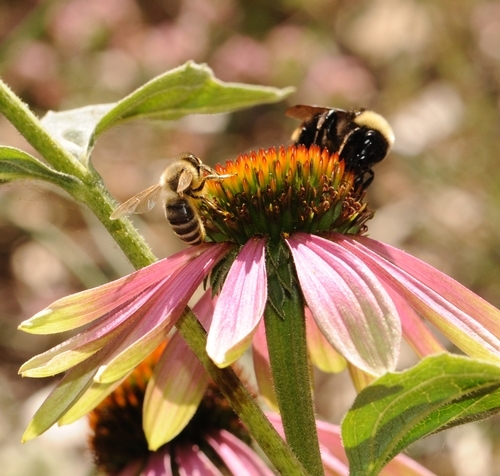
Häagen-Dazs wanted the funds to benefit sustainable pollination research, target colony collapse disorder, and support a postdoctoral researcher. It was decided to install an educational garden, conduct a design contest, and award a research postdoctoral fellowship to Michelle Flenniken (now with the Montana State University).
A Sausalito team--landscape architects Donald Sibbett and Ann F. Baker, interpretative planner Jessica Brainard and exhibit designer Chika Kurotaki--won the design competition. The garden was installed in the fall of 2009 under the direction of interim department chair Lynn Kimsey, director of the Bohart Museum of Entomology and professor of entomology.
An eight-member panel selected the winner of the design competition: Professor Kimsey; founding garden manager Missy Borel (now Missy Borel Gable), then of the California Center for Urban Horticulture; David Fujino, executive director, California Center for Urban Horticulture at UC Davis; Aaron Majors, construction department manager, Cagwin & Dorward Landscape Contractors, based in Novato; Diane McIntyre, senior public relations manager, Häagen-Dazs ice cream; Heath Schenker, professor of environmental design, UC Davis; Jacob Voit, sustainability manager and construction project manager, Cagwin and Dorward Landscape Contractors; and Kathy Keatley Garvey, communications specialist, UC Davis Department of Entomology.
Others who had a key role in the founding and "look" of the garden included the UC Davis Art/Science Fusion Program, founded and directed by the duo of entomologist/artist Diane Ullman, professor and former chair of the UC Davis Department of Entomology, and self-described "rock artist" Donna Billick. The art in the garden is the work of their students, ranging from those in Entomology 1 class to community residents. Eagle Scout Derek Tully planned, organized and built a state-of-the-art fence around the garden.
"The Honey Bee Haven will be a pollinator paradise," Kimsey related in December 2008. "It will provide a much needed, year-round food source for our bees at the Harry H. Laidlaw Jr. Honey Bee Research Facility. We anticipate it also will be a gathering place to inform and educate the public about bees. We are grateful to Haagen-Dazs for its continued efforts to ensure bee health."
The garden, Kimsey said, would include a seasonal variety of blooming plants that will provide a year-round food source for honey bees. It would be a living laboratory supporting research into the nutritional needs and natural feeding behaviors of honey bees and other insect pollinators.
Visitors to the garden, Kimsey related, would able to glean ideas on how to establish their own bee-friendly gardens and help to improve the nutrition of bees in their own backyards.
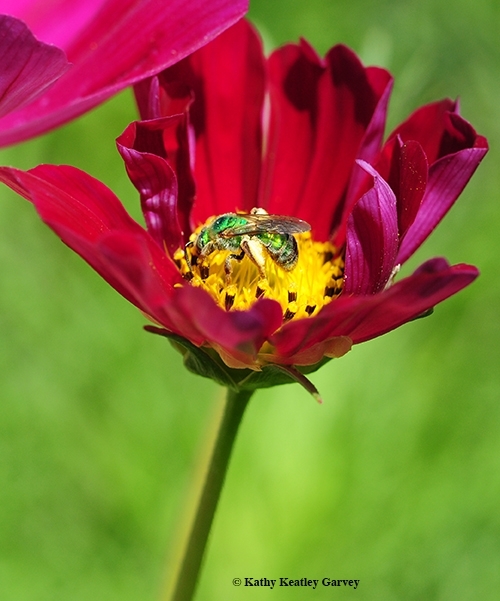
Feb. 19, 2008
Häagen-Dazs Donation to UC Davis
Dec. 8, 2008
Häagen-Dazs Launches Bee Garden Design Contest
Aug. 6, 2008
Insect Virus Researcher Michelle Flenniken Named Häagen-Dazs Postdoctoral Fellow at UC Davis
Feb. 26, 2009
Sausalito Team Wins Design Competition
Aug. 6, 2009
Haagen-Dazs Honey Bee Haven Site Preparation
Aug. 13, 2009
Bee Biology Website to Be Launched
Aug. 13, 2009
Thinking Outside the Box
Sept. 15, 2009
Campus Buzzway: Wildflowers
Dec. 15, 2009
Bee Biology Website Lauded
2010
June 6, 2010
Grand Opening Celebration of Honey Bee Garden
July 15, 2010
Art Is Where the Community Is; Blending Science with Art in the Häagen-Dazs Honey Bee Haven
July 30, 2010
More Than 50 Bee Species Found in Haven: Robbin Thorp (Now there's more than 80 and counting!)
Aug. 25, 2010
Donna Billick: Miss Bee Haven
Aug. 11, 2011
What the Signs Tell Us in the UC Davis Honey Bee Garden
Aug. 24, 2011
Royal Visit to Harry H. Laidlaw Jr. Honey Bee Research Facility
April 11, 2012
Brian Fishback: Spreading the Word about Honey Bees
Aug. 26, 2013
Eagle Scout Project: Fence Around the Bee Garden
2013
April 25, 2013
UC Davis Bee Team Wins Major Award
Aug. 1, 2013
Häagen-Dazs Honey Bee Haven Place to Be
With photo of founding volunteers
Attached Images:
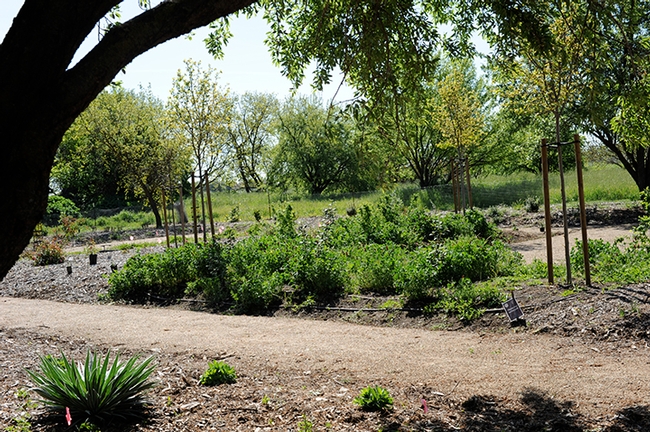
This photo, taken in 2010, shows the makings of the bee garden on Bee Biology Road, UC Davis campus. It was installed in the fall of 2009. (Photo by Kathy Keatley Garvey)
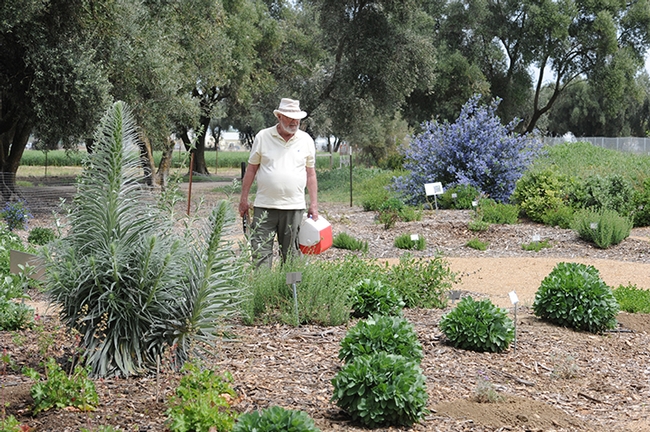
Distinguished emeritus professor of entomology, Robbin Thorp (Aug. 26, 1933-June 7, 2019), detected more than 80 species of bees in the garden. This image was taken in April 2011. (Photo by Kathy Keatley Garvey)
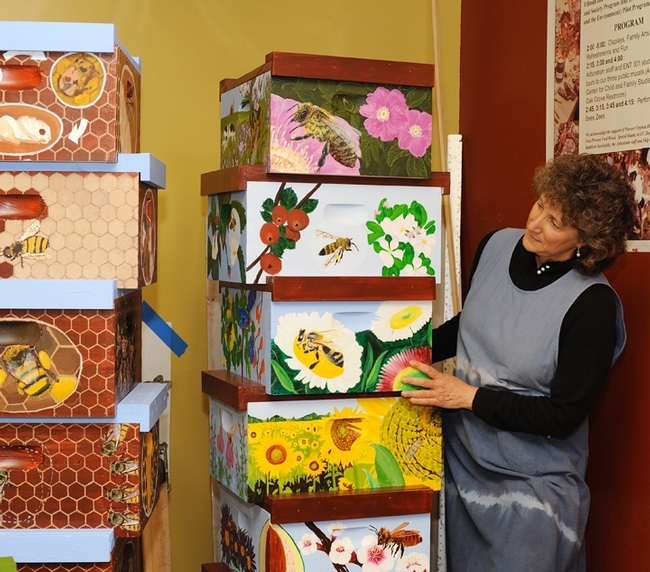
Professor Diane Ullman, former chair of the UC Davis Department of Entomology, with bee boxes that her students made for the bee garden. She and artist Donna Billick co-founded and co-directed the UC Davis Art/Science Fusion Program and provided art for the bee garden. (Photo by Kathy Keatley Garvey)
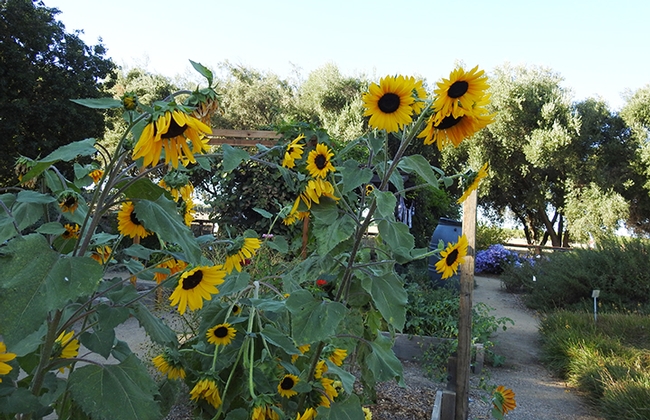
The bee garden today, 10 years later. (Photo by Kathy Keatley Garvey)